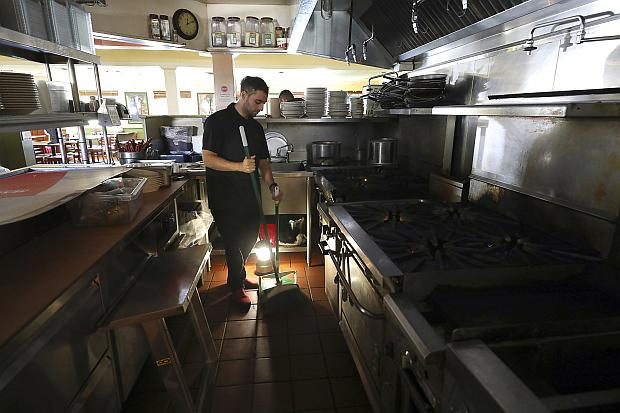California outages ease as wildfire threat moves south

Salvador Espinosa sweeps in the kitchen of a Mary’s Pizza Shack restaurant during a Pacific Gas and Electric Co. power shutdown in Santa Rosa, California, Thursday, Oct. 10, 2019. More than 1.5 million people in Northern California were in the dark Thursday, most for a second day, after the state’s biggest utility shut off electricity to many areas to prevent its equipment from sparking wildfires as strong winds sweep through the region. (Photo by Christopher Chung / The Press Democrat via AP)
SAN FRANCISCO — The lights were back on Friday for most of the nearly 2 million Northern California residents who lost electricity when the state’s largest utility switched it off this week in an effort to prevent wildfires.
The threat of widespread outages loomed in Southern California after the winds moved to the Los Angeles area, where a wildfire fueled by strong Santa Ana winds prompted officials to order the evacuation of 100,000 people from their homes in the foothills of the San Fernando Valley in Los Angeles County.
In that fire, one man went into cardiac arrest and died at the scene.
Pacific Gas & Electric Co. restored power in Northern California after workers inspected power lines to make sure it was safe. The winds had increased the possibility of transmission lines toppling to the ground or being hit by tree branches and starting wildfires.
The utility said it found 30 instances of weather-related damage to its equipment during the shutdown.
Article continues after this advertisementBy Friday evening, PG&E said it had restored power to 97% of the 738,000 homes and businesses affected by the deliberate blackout that began Wednesday. About 21,000 customers remained without power.
Article continues after this advertisementExperts have said there are between two and three people for every electrical customer.
More than 6,000 ground workers and 44 helicopters were making safety inspections, which could only take place in daylight and were expected to resume at daybreak Saturday, PG&E said.
The El Dorado County Sheriff’s office said Friday that an autopsy determined that the death of 67-year-old Robert Mardis minutes after the blackout was due to severe coronary disease, not the loss of electricity. The office said the investigation has closed.
Marie Aldea of Pollock Pines had previously said Mardis, her 67-year-old father, was asleep when the electricity went out around 3:30 a.m. Wednesday and likely couldn’t wake up in time to get his back up machine, which ran on battery.
“We were all asleep, we heard my mom scream. She was crying,” she told KTXL-TV in Sacramento . “My dad went down in her arms, he was going for this oxygen machine.”
Aldea said her father’s health was poor, but she doesn’t understand why the utility turned off the power.
“No winds at all. And because of that, my father is gone,” she said.
Some people in the largely rural Butte, Plumas and Yuba counties and in Northern California’s wine country counties were in their third day without electricity.
Butte County is where a fire started by PG&E equipment last year decimated the town of Paradise and killed 85 people. In Napa and Sonoma counties north of San Francisco, the outages began on the two-year anniversary of deadly wildfires that killed 44 and destroyed thousands of homes.
PG&E faced hostility and second-guessing over the shut-offs, which prompted runs on supplies like coolers and generators and forced institutions to shut down.
Ryan Fisher, a partner in consumer goods and retail practice at global consultancy A.T. Kearney estimated $100 million in $200 million in fresh food was likely lost because of the outages along with $30 million a day in consumer spending.
PG&E cast the blackouts as a matter of public safety to prevent the kind of blazes that have killed scores of people over the past couple of years, destroyed thousands of homes, and ran up tens of billions of dollars in claims that drove the company into bankruptcy.
The utility suggested it was already seeing the wisdom of its decision borne out as gusts topping 77 mph (122 kph) raked some hilltops where wildfire risk was extremely high.
Utility CEO Bill Johnson promised if future wind events require similar shut-offs, the utility will “do better” at communicating with customers. It’s unacceptable that its website crashed, maps were inconsistent and call centers were overloaded, Johnson said.
“We were not adequately prepared,” he said.
/atm